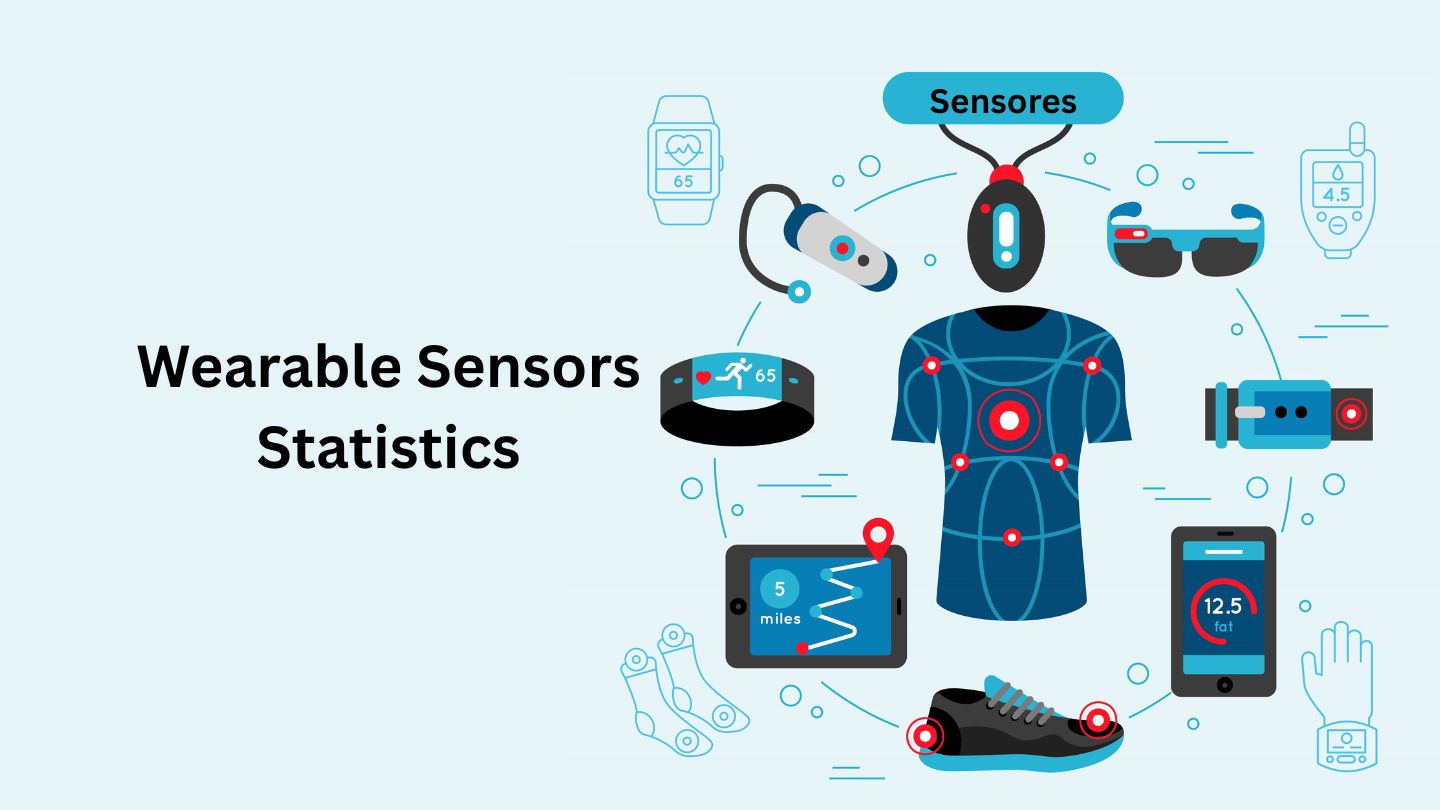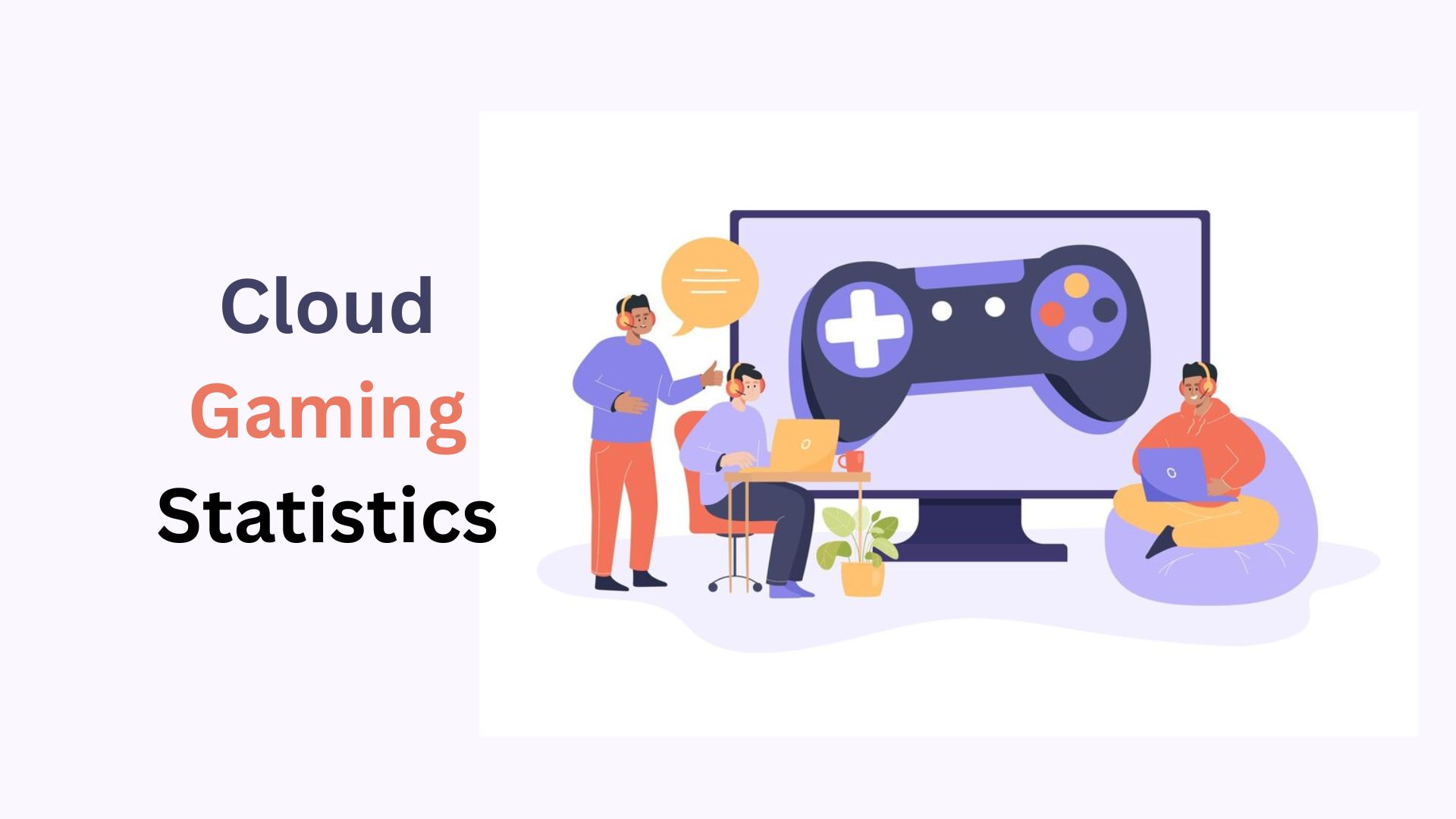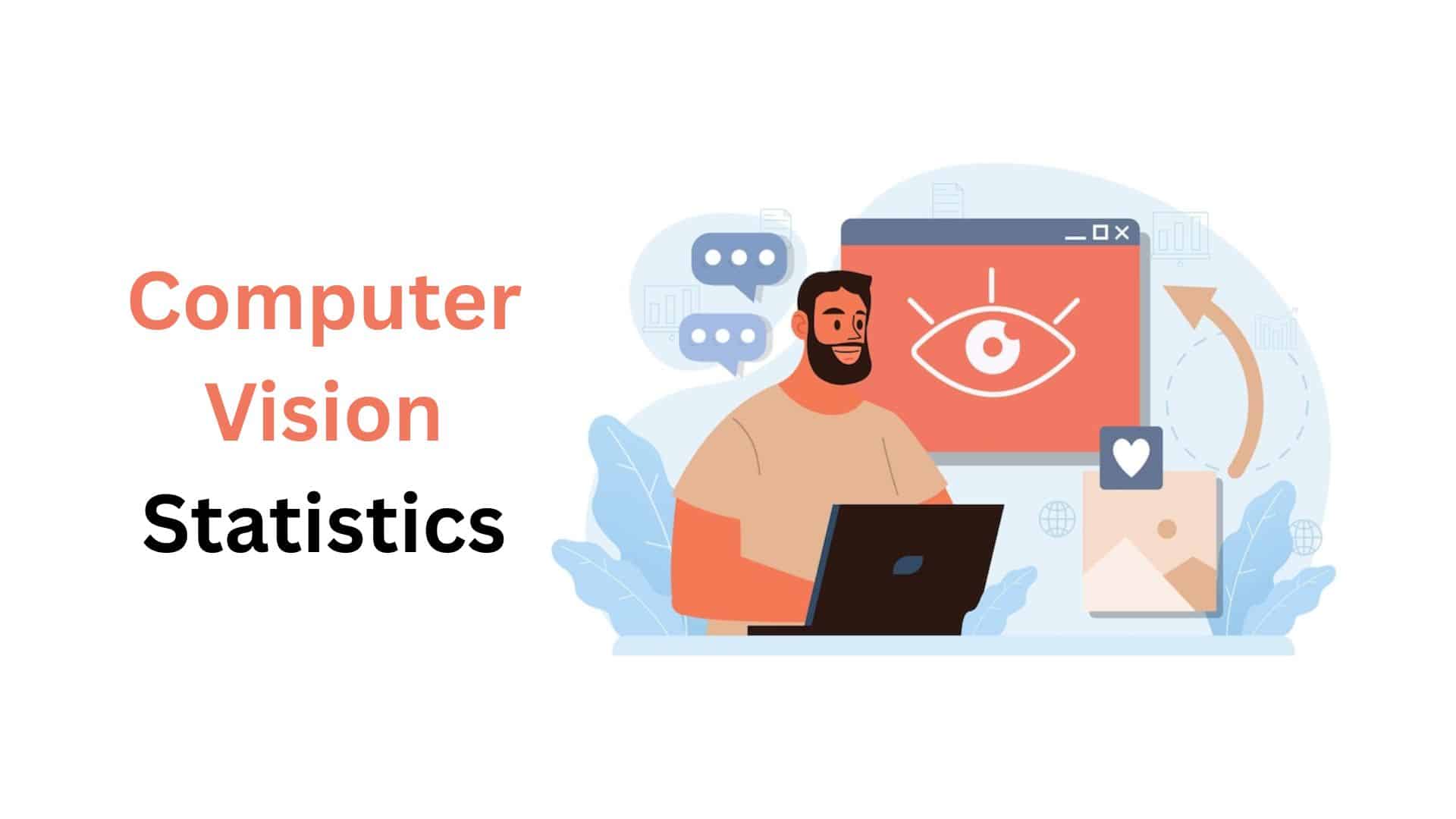Technology Addiction Statistics By Demographics, Social Media and Facts

Updated · Mar 07, 2025


TABLE OF CONTENTS
- Introduction
- Editor’s Choice
- What is Technology Addiction?
- Different Types of Technology Can Contribute to This Addiction in Different Ways.
- General Technology Addiction Statistics
- Effects of Technology and Internet Statistics
- Technology Addiction Demographics Statistics
- Teen Addiction to Smartphone Statistics
- Social Media Addiction Statistics
- Average Daily Time Spent Using the Internet
- Impact of COVID-19 Pandemic on Smartphone Addiction Statistics
- Devices Used By People to Access Internet Statistics
- Conclusion
Introduction
Technology Addiction Statistics: Technology has become a big part of daily life, but too much use can lead to addiction. Many people spend hours on smartphones, social media, gaming, and the internet, often without realising how much time they are using. As technology addiction has grown in recent years, it has affected mental health, sleep, and work efficiency.
In 2024, studies found that more than 60% of people check their phones within five minutes of waking up. Many feel anxious when away from their devices. This article shares key statistics, the effects of Technology Addiction, and tips to manage screen time for a healthier balance between digital use and daily life.
Editor’s Choice
- As of January 2025, there are 4.66 billion internet users worldwide, representing 59.5% of the total world population.
- Approximately 85% of American adults go online daily, with 31% reporting they are online “almost constantly.”
- Technology Addiction Statistics show that in 2025, almost 67% of adults and 76% of children in the United States will be video game players, indicating a high level of engagement with gaming technologies.
- As of 2025, 55.1% of the global population uses social media, spending an average of 2 hours and 22 minutes per day on these platforms.
- Teenagers spend over seven hours a day in front of a screen, not including time spent on schoolwork.
- Meanwhile, an estimated 105.6 million gamers worldwide are considered addicted to video games.
- On average, Americans check their phones 96 times a day, approximately once every 10 minutes.
- Around 75% of children and 70% of adults use electronic devices in their bedrooms before going to sleep, contributing to disturbed sleep patterns.
- Over 35% of people have an internet addiction.
- Smartphone use is involved in 26% of car accidents in America.
What is Technology Addiction?
Technology addiction happens when a person uses technology in a way that is obsessive and frequent, even though it harms their life. For students, depending too much on technology can negatively affect their well-being. While technology is necessary in today’s world, being overly dependent on it—or becoming addicted to certain types of technology—can cause social and emotional problems. Teenagers who are addicted to technology might feel isolated, anxious, or depressed and may struggle when they can’t use their devices.
Technology is good at meeting our basic human needs for excitement, interaction, and variety. When teenagers go through difficult situations, like a breakup or a bad grade, technology can be a quick way to escape or feel better. But this can lead to addiction. Like alcohol or drugs, technology can give people pleasure or relief, triggering the brain’s reward system and providing a sense of escape.
Different Types of Technology Can Contribute to This Addiction in Different Ways.
The Internet
- The Internet is highly addictive because it gives instant access to endless information.
- People can use it on different devices like computers, smartphones, tablets, and smartwatches.
- Many teenagers experience FOMO (Fear of Missing Out), which makes them stay online to keep up with important news and social updates.
- Some also use social media, like Facebook, to cope with sadness or anxiety.
- Since the Internet is always available, it becomes difficult to take a break, even when they want to.
Video and Computer Games
- Video games are addictive because they make players feel accomplished.
- Games set challenges and reward players with virtual prizes or higher rankings, which gives them a sense of success.
- These games also allow players to interact with others who share the same interests.
- Through online communities, YouTube, or social media, they keep discussing and playing together.
- Some people even escape reality through games, creating new identities or exploring exciting virtual worlds.
Smartphones, Tablets, and Smart Devices
- Smartphones and other gadgets are always accessible, making them highly addictive.
- Since they are portable, people can use them anytime and anywhere. This makes it hard to resist using them for browsing, gaming, or social media.
Social Media
- Social media helps people stay connected by providing easy communication.
- Platforms like Facebook, Instagram, Twitter, and Snapchat show constant updates from friends or influencers.
- It allows people to interact without meeting in person, which can feel more comfortable.
- However, frequent use can lead to addiction, making people rely on online interactions instead of real conversations.
General Technology Addiction Statistics
- Studies show that internet addiction is a growing issue, with over 35% of people struggling with some form of it.
- This problem has worsened during and after the COVID-19 pandemic as people have become more dependent on the Internet for work, school, and entertainment.
- Technology Addiction Statistics stated that around 31% of U.S. adults say they are online almost all the time, and 85% of Americans use the Internet daily.
- Teenagers spend an average of 8 hours per day in front of screens, which is a lot of time.
- Over 50% of Americans believe they are addicted to their smartphones. 80% of Gen Z check their phones within 5 minutes of receiving a notification, and more than half of teens feel they spend too much time on their phones. Most teens also check their phones right after waking up.
- Around 40% of young adults aged 18–22 say they are addicted to social media, and about 10% of social media users in the U.S. report addiction.
- 1 in 3 people believe social media negatively affects their mental health, with apps like Instagram being linked to body image issues.
- As mentioned in Technology Addiction Statistics, technology addiction is affecting around 1.65 billion people worldwide, with 44% of teenagers finding it hard to take breaks from their devices.
- In the U.S., the average person spends over seven hours daily looking at screens, while 22% of people are online almost all the time.
- Studies suggest that about 6% of the global population is addicted to the Internet, with 25% of teenagers showing signs of dependence.
- Men are slightly more prone to tech addiction than women.
- Smartphone addiction alone affects over 399 million people, with Americans using their phones for nearly three hours per day.
- More than 14 million U.S. teens may have a mild addiction to social media, while 5% of young people in the EU face similar struggles.
- Around 40% of adults on social media show some depression symptoms, and 8.8% experience more severe effects.
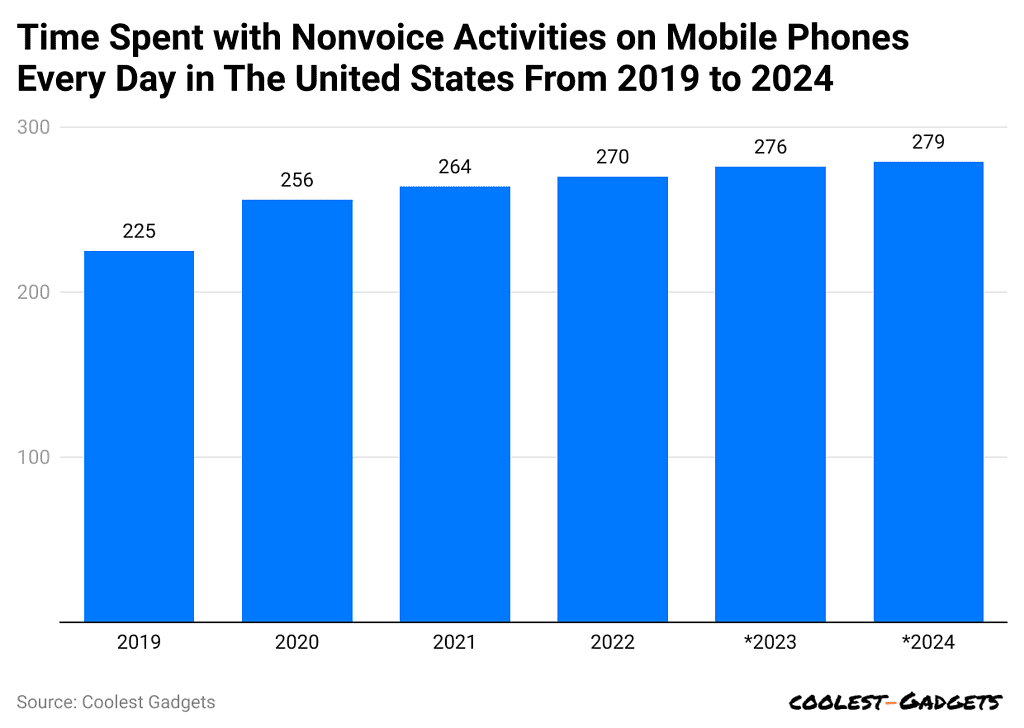
(Reference: sellcell.com)
- Teens who spend too much time on social media may face a higher risk of suicidal thoughts as they grow older.
- More than 60 million people around the world are addicted to video games, with young adults aged 16–29 being over twice as likely to develop gaming addiction compared to older individuals.
- Around 30% of phone addicts lead an unhealthy lifestyle, eating more junk food and exercising less.
- One in three people struggles with daytime sleepiness due to staying up late on their phones.
- Those addicted to smartphones are also more likely to feel depressed, with 30% reporting symptoms of depression.
- Teens who use their phones for more than four hours daily have a greater chance of experiencing suicidal thoughts.
- Different types of technology addiction, such as addiction to social media, smartphones, and online content, are linked to increased levels of anxiety, loneliness, and depression. Watching adult content online also raises feelings of isolation.
Effects of Technology and Internet Statistics
- Internet and technology addiction can have serious effects on both your mind and body, and it’s important to pay attention to the warning signs.
Mental Effects of Technology Addiction
- Depression – Feeling sad or down for a long time.
- Guilt – Feeling bad about using the Internet or technology too much.
- Anxiety – Feeling nervous or worried, especially when you can’t use technology.
- Euphoria – Feeling extremely happy or excited when using the Internet or technology.
- Trouble with priorities – Difficulty focusing on what’s important or putting off tasks.
- Isolation – Spending more time alone, avoiding family and friends, in favour of being online.
- Losing track of time – Spending more time online than planned and forgetting about other tasks.
- Defensiveness – Getting upset or angry if someone comments on how much you use technology.
- Avoiding responsibilities – Ignoring work or school tasks to use devices.
- Mood swings – Sudden changes in mood, such as feeling irritable when you can’t access your devices.
- Fear of being offline – Anxiety about not having access to the Internet or technology.
- Loneliness – Feeling alone, even when surrounded by people, because of too much screen time.
- Boredom – Feeling uninterested or restless without technology.
- Memory loss – Forgetting things because you’re distracted by screens or devices.
Physical Effects of Technology Addiction
- Back pain – Pain from sitting in one place for too long while using a device.
- Carpal tunnel syndrome – Numbness or pain in your hands from too much typing or phone use.
- Headaches – Regular headaches from looking at screens for long periods.
- Insomnia – Trouble falling asleep, especially when using screens before bed.
- Unhealthy eating habits – Eating junk food or skipping meals because of too much time online.
- Poor personal hygiene – Neglecting personal care because of excessive screen time.
- Neck pain – Soreness in the neck from poor posture while using devices.
- Eye problems – Dry eyes or blurry vision from staring at screens too much.
- Weight changes – Gaining weight from lack of activity or losing weight from neglecting meals.
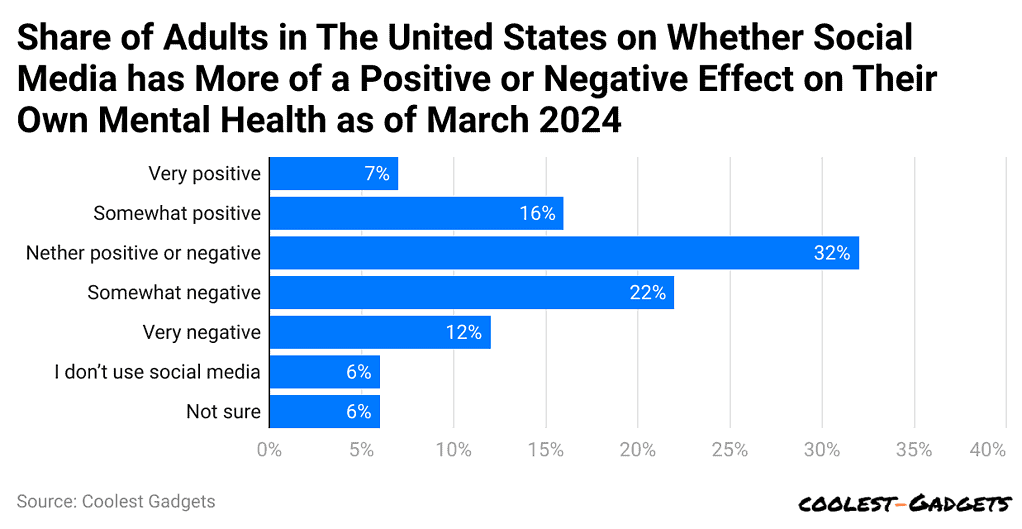
(Reference: sellcell.com)
Social Effects
- Learning difficulties – Children and students may have trouble focusing and doing well in school.
- Strained relationships – Adults may have problems with their family or friends because they spend too much time online.
- Lack of focus – Struggling to stay focused at work or school when distracted by technology.
Technology Addiction Demographics Statistics
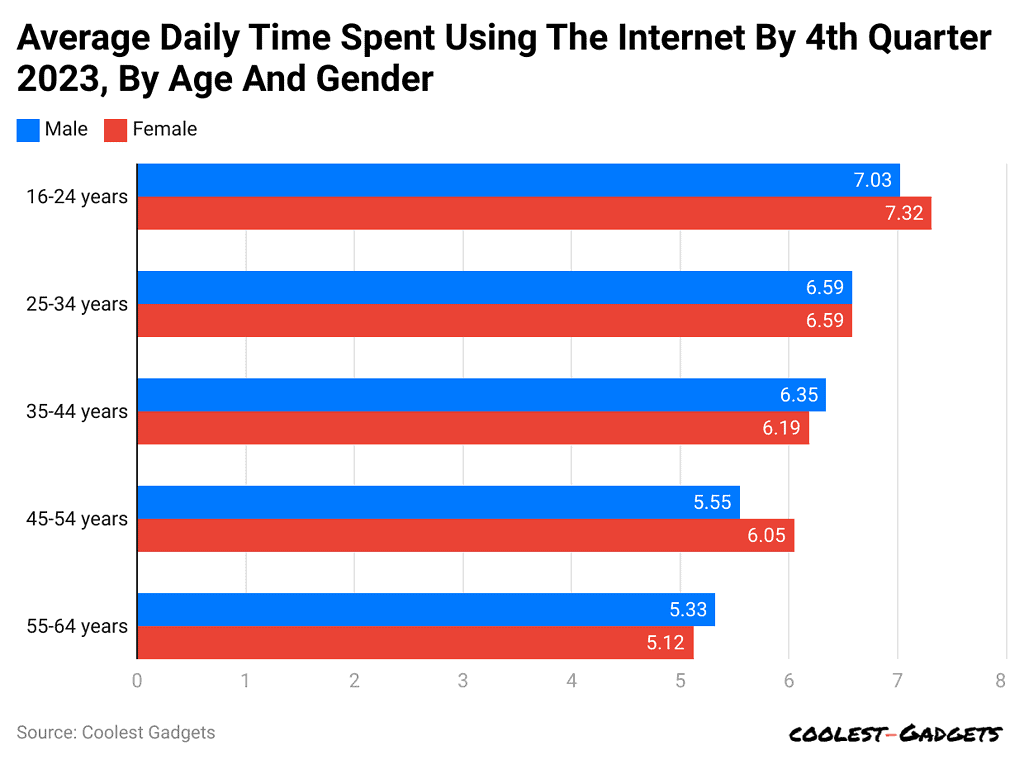
(Reference: sellcell.com)
| Age Group | Male | Female |
|
55-64 years |
5.33 | 5.12 |
| 45-54 years | 5.55 |
6.05 |
|
35-44 years |
6.35 | 6.19 |
| 25-34 years | 6.59 |
6.59 |
|
16-24 years |
7.03 |
7.32 |
- In the 16-24 age group, females spend more time online each day, averaging 7.32 hours, while males spend slightly less at 7.03 hours.
- This could be because more women in this age group use social media apps like TikTok, with 57% of females using it compared to 43% of males.
- In the 25-34 age group, both males and females spend about the same amount of time online, around 6.59 hours a day.
- People in the 35-44 age group spend less time on the Internet. According to Technology Addiction Statistics, males spend 6.35 hours, while females spend 6.19 hours.
- In the 45-54 age group, women spend more time online than men, averaging 6.05 hours compared to 5.55 hours for men.
- It needs to be clarified why women in this age group spend more time on the Internet than men.
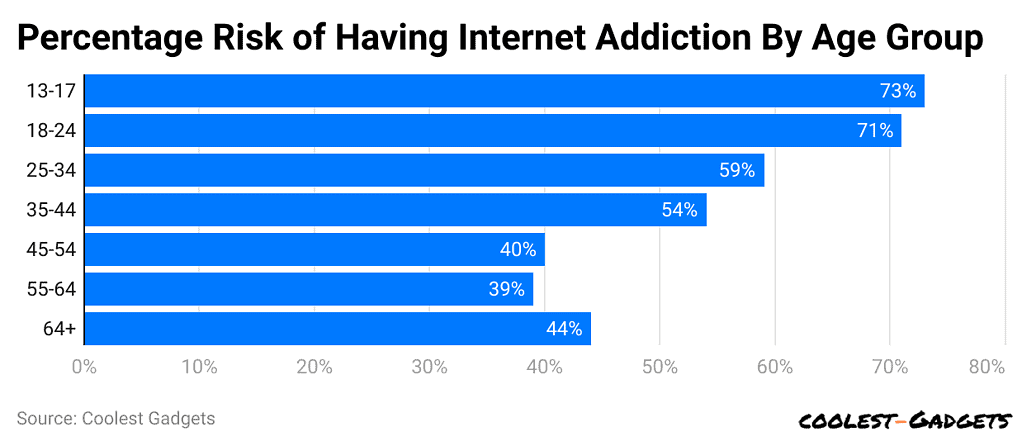
(Reference: sellcell.com)
- In the above chart, we can see the percentage risk of people having internet addiction by age group.
| Age Group | % |
| 64+ | 44% |
| 55-64 | 39% |
| 45-54 | 40% |
| 35-44 | 54% |
| 25-34 | 59% |
| 18-24 | 71% |
| 13-17 | 73% |
The data shows worrying trends about internet addiction risks across different age groups:
- 73% of 13-17-year-olds are at risk of becoming addicted to the Internet.
- The 18-24 age group isn’t far behind, with 71% at risk.
- Among 25-34-year-olds, 59% are at risk of developing internet addiction.
- In the 35-44 age group, 54% have a likelihood of addiction.
- For those aged 45-54 and 55-64, the risk drops slightly to 40% and 39%, respectively.
- People aged 64 and older show a slightly higher risk of 44%, likely because many retirees spend more time online at home.
Teen Addiction to Smartphone Statistics
- Young people love hanging out with friends, going to parties, and visiting cool places, and they often share these moments on social media.
- With smartphones being a big part of everyday life, the risk of developing an addiction to them is growing.
- Teenagers, in particular, tend to spend a lot of time on their phones because they fear missing out on things. This leads to high usage rates.
- 78% of teens check their phones at least once every hour.
- Technology Addiction Statistics stated that almost 72% believe teens should always reply quickly to texts and messages.
- Nearly 33% of teens and parents disagree on how much time teens should spend on their phones.
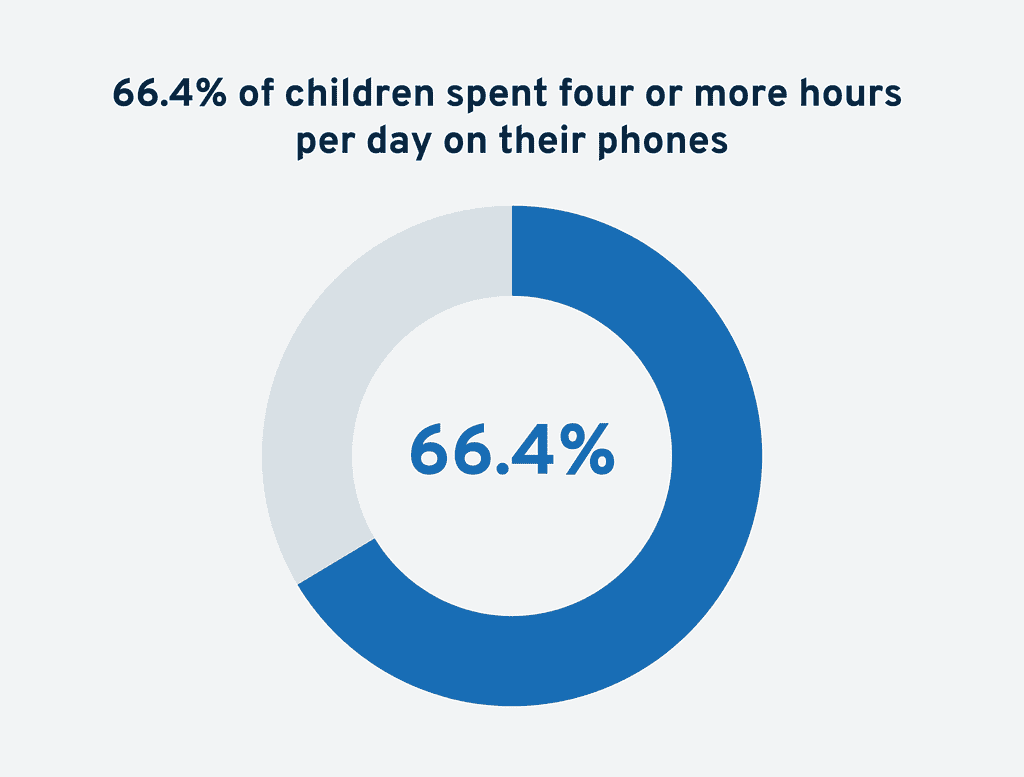
(source: niagararecovery.com)
- 33% of teens prefer texting their friends rather than meeting in person.
- Despite this, 69% still prefer meeting close friends face-to-face instead of chatting online.
- 41% of teens feel stressed out by the number of notifications they get each day.
- Technology Addiction Statistics stated that around 80% of teens use their phones in bed before going to sleep.
- 70% of teens mostly use just 3-5 apps on their phones.
- Almost 49% say their attention span has gotten shorter because of smartphone use.
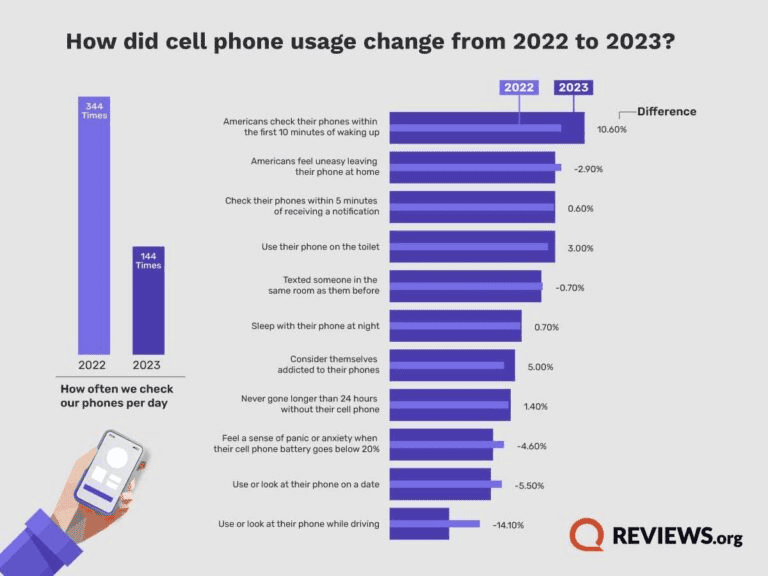
(source: niagararecovery.com)
- People living in urban areas are the most likely to be online all the time (37%), followed by those in suburban areas (30%) and rural areas (23%).
- People with higher incomes are also more likely to be addicted to their phones. 40% of individuals with an annual income over USD 75,000 report being addicted to technology.

(Reference: demandsage.com)
Following are the details about the cost of hours that are spent by different generations on their smartphones:
- Boomers: 3hrs 38 minutes
- GenX: 4 hrs 44 minutes
- Millennials: 5hrs 57 minutes
- GenZ: 6hrs 37 minutes
The following are the most used smartphone applications by teenagers:
- TikTok is the most popular app among teens, with 60% using it regularly.
- 55% of teenagers prefer Snapchat for sharing pictures and videos with friends. Half of all teens use Instagram to post content for their followers.
- YouTube attracts 46% of young users for watching videos and listening to music.
- WhatsApp helps 33% of teens stay in touch with family and friends. Facebook, though less popular now, still has 30% of teen users. 12% follow news on Twitter, while 10% explore ideas on Pinterest.
- Discord is used by 9% for gaming chats, and 6% visit Reddit for memes and discussions.
Social Media Addiction Statistics
- Technology Addiction Statistics stated that almost 40% of American internet users aged 18 to 22 say they feel addicted to social media.
- 5% of young people aged 18 to 22 believe the phrase “I am addicted to social media” perfectly describes them.
- In countries like the Philippines, Malaysia, South Africa, and Kenya, more than 70% of adults get their news from social media.
- Overall, 34% of women in the U.S. say they are addicted to social media.
- 11% of women agree with the statement, “I am addicted to social media.”
- People with lower incomes may be more likely to become addicted to social media.
- Technology Addiction Statistics stated that around 55% of U.S. drivers admit to using social media while driving.
- A study shows that receiving “likes” on social media triggers the same part of the brain in teenagers as money or eating chocolate.
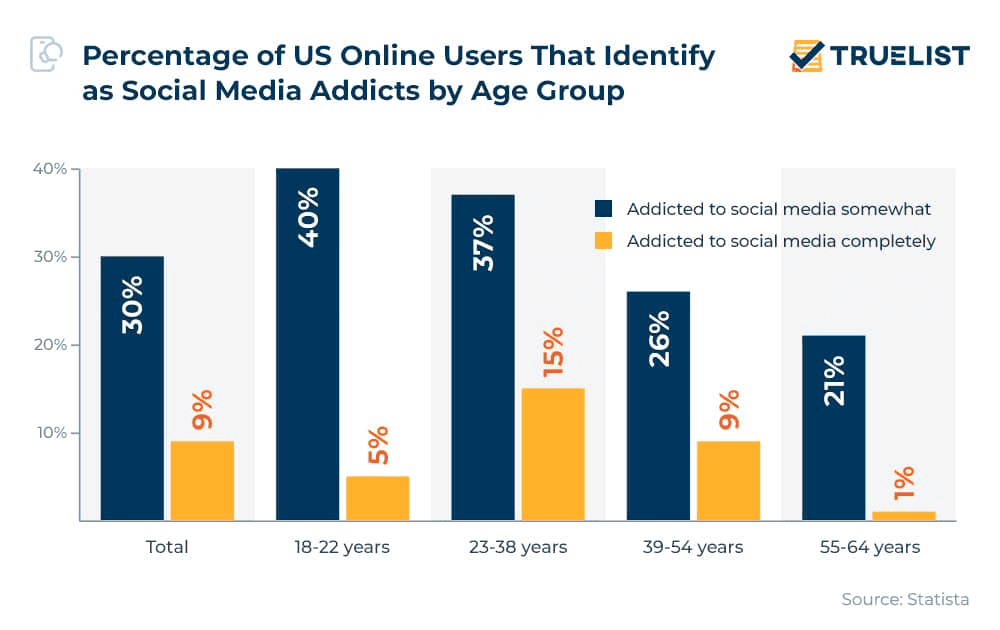
(Source: truelist.co)
- Nicholas Kardaras, author of *Glow Kids*, says that too much social media overstimulates the brain, causing it to go into “fight-or-flight” mode. This worsens issues like ADHD, teen depression, anxiety, and oppositional defiant disorder.
- Using social media too much trains the brains of teenagers to always seek instant rewards, which can lead to other addictive behaviours.
- In the U.K., 48% of social media users aged 16 to 18 feel addicted to social media.
- Technology Addiction Statistics stated that around 57% of teen girls feel addicted to social media, compared to 37% of boys.
Average Daily Time Spent Using the Internet
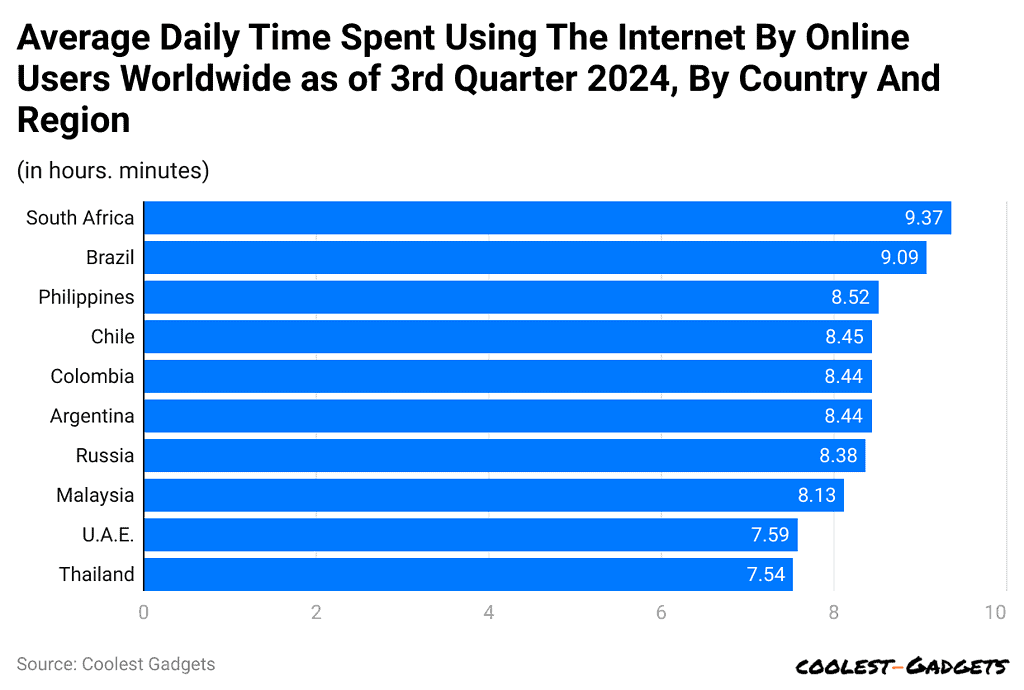
(Reference: statista.com)
- Technology Addiction Statistics show that as of the third quarter of 2024, South Africa had the highest internet usage, with people spending over 9 hours and 37 minutes online each day.
- Brazil ranked second, where users spent 9.09 hours daily on the internet.
- During the same period, the average daily time spent on the internet in other countries was 8.52 hours, followed by the Philippines (8.52 hours), Chile (8.45 hours), Colombia (8.44 hours), Argentina (8.44 hours), Russia (8.38 hours), Malaysia (8.13 hours), the U.A.E. (7.59 hours), and Thailand (7.54 hours).
Impact of COVID-19 Pandemic on Smartphone Addiction Statistics
- Internet use, especially excessive use, increased during the COVID-19 pandemic. A worldwide study found that 33.37% of users developed problematic internet habits.
- 3% of people in South Korea said they started using their smartphones more because of COVID-19.
- The same study showed that 49% of people used their smartphones during COVID-19 to stay in touch with others. Other common uses were reading the news (47.2%), shopping online (34.6%), and taking photos or videos (29%).
- 2% of people used their phones to read the news, 34.6% for online shopping, and 29% for photos and videos.
- According to Technology Addiction Statistics, 37% of people said they texted more during the pandemic than before.
- Technology Addiction Statistics stated that almost 61% of users said they began texting much more during COVID-19.
Devices Used By People to Access Internet Statistics
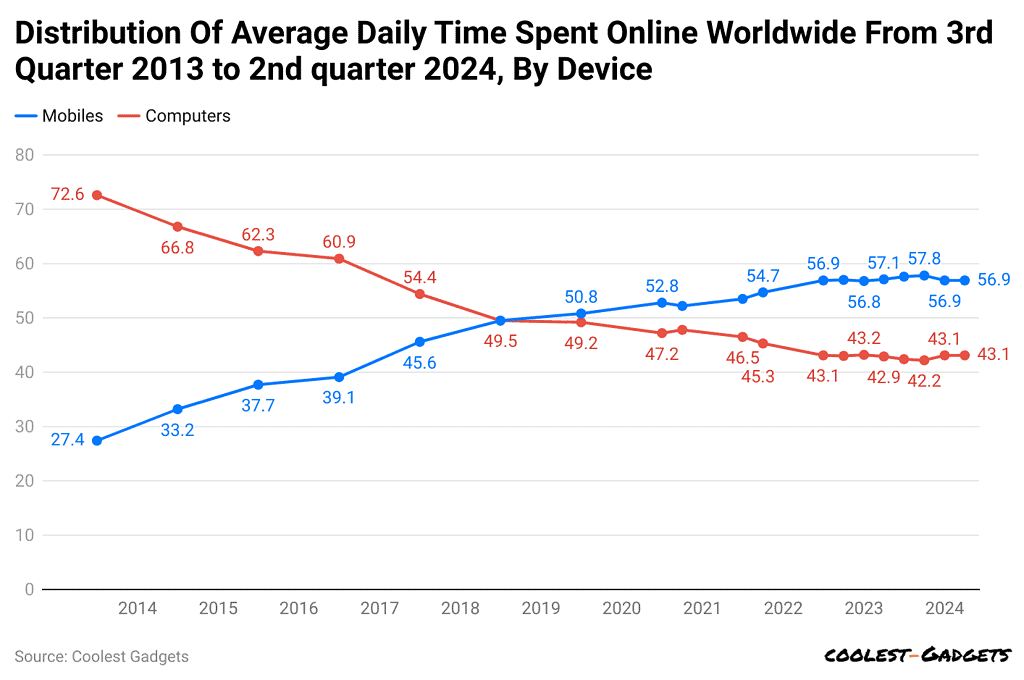
(Reference: sellcell.com)
- As expected, in Q3 of 2013, more people (72.6%) accessed the Internet through a computer, while only 27.4% used a mobile phone. This makes sense because mobile Internet was less advanced back then than it is now.
- By Q3 of 2018, the numbers were much closer, with 49.5% of people using a computer and 50.5% using a phone to go online.
- By Q4 of 2023, smartphones took the lead, with 57.8% of people using their phones to access the Internet, compared to 42.2% who still used computers. This trend seems to have stabilised, with little change expected going forward.
Conclusion
Technology addiction is becoming a bigger issue for people of all ages, as we have seen from the above Technology Addiction Statistics. It can harm our physical health, affect our relationships, and hurt our performance at school or work. By understanding how common and serious this problem is, we can take steps to have a healthier relationship with technology.
To avoid the risks of addiction, it’s important to set limits on screen time, recognise when you’re spending too much time on devices, and get help from family, friends, or experts. It’s also important to understand why tech addiction happens and how to control it. Raising awareness, providing resources for prevention and treatment, and promoting healthy tech habits are key steps to dealing with this problem.
Sources
FAQ.
Technology addiction happens when someone uses technology too much, causing issues in their life. Instead of using it for fun, they turn to technology to help them cope with stress, anxiety, or frustration.
China has the highest rate of smartphone addiction. Smartphones have become so important in our lives that they manage almost everything for us, making them feel like an extra hand.

Saisuman is a talented content writer with a keen interest in mobile tech, new gadgets, law, and science. She writes articles for websites and newsletters, conducting thorough research for medical professionals. Fluent in five languages, her love for reading and languages led her to a writing career. With a Master’s in Business Administration focusing on Human Resources, Saisuman has worked in HR and with a French international company. In her free time, she enjoys traveling and singing classical songs. At Coolest Gadgets, Saisuman reviews gadgets and analyzes their statistics, making complex information easy for readers to understand.







